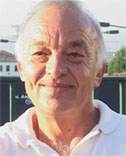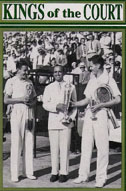Elements of
Serving Greatness
Ed Atkinson
The Serve
Undoubtedly, the most potent weapon in a tennis player's arsenal is an effective serve. The serve can dictate the course of the point from the very beginning and it is the only stroke that allows a player complete control of the ball, from start to finish. So critical is the possession of a good serve, that, theoretically, a player who wins all his service games, and each tiebreaker service point, is invincible.
Throughout the history of tennis, less than ten players have met the criteria for service greatness. Four of these are Bill Tilden, Ellsworth Vines, Jack Kramer, and Pancho Gonzales. This article, and the second part to follow in the next issue, explores the techniques that made them among the best servers in the history of the game.
The three essential elements of a devastating serve, in order of importance, are:

- Accuracy
- Disguise
- Power
Accuracy includes both a high percentage of first serves in play, and the ability to place the ball close to any line in the service box, as well as to serve into the receiver's body. As players and spectators, we have all witnessed countless aces resulting from well placed serves of moderate speeds
Disguise is also essential. Good servers do not indicate where they intend to place their serve either by their ball toss or body position. Instead, the ball is tossed to the identical place from the identical foot placement on every serve, regardless of where the server is aiming.
Only when the elements of accuracy and disguise have been mastered does power become a factor. Power alone will only result in a service fault or a or powerful service return. No matter how hard a player serves, other factors are more critical to serving effectiveness. First, a player must serve a high percentage of first serves. Second, serves must be placed in an area that causes a problem for the receiver. Third, the area of placement must be well disguised from the receiver. It is only when accuracy, disguise, and power co-exist that a serve can be classified as "great.
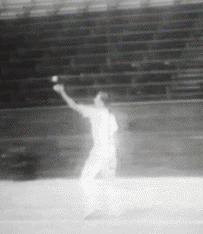
How Good Were These Guys?
Gene Mako told me that in 1920, Tilden's serve was timed at 150mph. Gene also told me that on two separate occasions in tournaments he saw Tilden place 4 balls in his left hand at the start of a service game and serve four consecutive aces.
Ellsworth Vines can arguably be considered the greatest server in tennis history. In a 1939 match tour against Don Budge, Vines averaged 2.5 aces per game. This was the exact same ratio as in the 1932 Wimbledon final, where Vines defeated Bunny Austin 6-4, 6-2, 6-0. In his 12 service games Vines served 30 aces.
Jack Kramer's first service percentage hovered at 75% throughout his career. Although it can not be confirmed by any record book, I feel virtually certain no player ever won more service games with one break than Kramer.
Pancho Gonzales was so certain of his ability to hold serve that, even in big matches, he would often not make a serious attempt to break serve until late in the set. Pancho would lull his opponent into a comfortable tempo, then increase it dramatically on his return games at the critical times. In the 50 or so matches I saw him play, it seemed that on the rare occasions that he faced a break point, he never missed a first serve.
Tilden |
Vines |
Click Buttons to see rare streaming video of Bill Tilden and Ellsworth Vines, two of the greatest servers of all time. |
|
Throughout the history of tennis, less than ten players have met the criteria for greatness on the serve. Four of these are Bill Tilden, Ellsworth Vines, Jack Kramer, and Pancho Gonzalez. In part two of this article, we discuss the more elements their serves had in common, as well as some of the differences that made each server unique.
The Grip
All four players served with a grip somewhere between the Eastern forehand and Eastern backhand, on both the first and second serves.
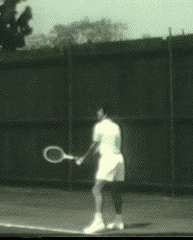
Starting Position
All four players commenced the serve with their rear foot set almost directly behind their front foot, about 18 inches apart. On the second serve, in order to obtain spin, they might draw the rear foot back slightly.
The Toss
The most disciplined and consistent toss was developed by Jack Kramer. Jack actually rejected the word "toss." Instead he "placed" the ball in exactly the correct position on every serve, with no spin, so that he could read the label on the ball before he made contact. Jack told me if the ball was placed correctly, on a first serve, and was allowed to bounce on the ground instead of being struck, it should land in an area approximately two feet in front of and slightly to the right of the left foot.
To master the toss, Jack suggested I place a handkerchief in that area and practice until 100 balls in a row landed on the handkerchief. All four players placed the ball in front of them (into the court) and either slightly to their right or in line with their heads. They never placed the ball, on a first serve, in a position where they would have to arch their backs to hit it. Arching the back is necessary on a second serve, but is a fatal defect on a first serve due to the loss of power that ensues.
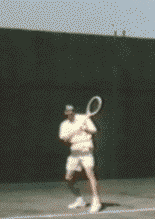
Point of Contact
It is here that the four servers part company. Tilden hit the ball on its way up. This technique requires more delicate timing, but it has the advantage of providing the receiver less time to anticipate the direction of the serve.
Ellsworth Vines told me he first perfected contacting the ball at its peak, while it was motionless in the air, but through experimentation he found he could get more power by hitting the ball on its way down. He said he didn't know the physics involved, but, perhaps, more power can be generated through forward thrust on an object moving downward than a motionless one. Nevertheless it worked for him.
As you can see from the animations, both Kramer and Gonzales hit the ball just as it began to drop.
The Swing
All four players hit the ball with their elbow pointed toward the net. Therefore, they received the benefit of leverage created by the elbow joint, as well as the wrist joint. All four had their racket hand sweeping close to their heads just prior to hitting the ball.
A final element all four employed was the swinging their right foot into the court on the follow through, the exact action employed by baseball pitchers everywhere. The current technique of jumping vertically and landing first on the left front foot deprives the server of forward thrust and the ability to serve a "heavy" ball. It also causes the server to lose a step or two if he is following his serve to the net.
Each of the four players had a unique and distinctive motion. Yet all of these all time great possessed great fluidity of motion and fundamental technical excellence that made them legendary servers--servers we can still learn from in the new millennium.



